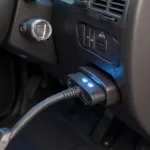OBD2 distributor wiring on connectors can seem complex, but with a little knowledge, you can easily understand how it works. This guide will break down everything you need to know, from the basic principles of distributor wiring to troubleshooting common issues. We’ll explore the various components, their functions, and how they all connect within the OBD2 system.
Decoding the OBD2 Distributor Wiring System
The distributor, although largely replaced by electronic ignition systems in modern vehicles, played a vital role in older cars. It was responsible for distributing high voltage to the spark plugs at the correct time, ensuring proper combustion. Understanding the wiring of this component is crucial for diagnosing issues in vehicles still equipped with them. The OBD2 system, while not directly connected to the distributor’s operation, can provide valuable information about the overall engine performance, which can be affected by faulty distributor wiring.
Key Components of the Distributor Wiring
The distributor wiring consists of several key components:
- Ignition Coil: This transforms the low voltage from the battery into the high voltage needed for the spark plugs.
- Distributor Cap and Rotor: These work together to distribute the high voltage from the ignition coil to the correct spark plug wire.
- Spark Plug Wires: These carry the high voltage from the distributor cap to the spark plugs.
- Pick-up Coil (or Hall Effect Sensor): This sensor tells the ignition module when to fire the spark plugs.
- Ignition Module: This controls the timing and firing of the spark plugs based on input from the pick-up coil and other sensors.
 OBD2 Distributor Wiring Diagram Explained
OBD2 Distributor Wiring Diagram Explained
How the Distributor Wiring Connects
The high voltage from the ignition coil is sent to the center of the distributor cap. The rotor, spinning inside the cap, directs this high voltage to the individual terminals on the cap, which are connected to the spark plug wires. The pick-up coil or Hall effect sensor within the distributor sends a signal to the ignition module, indicating the position of the rotor and therefore which cylinder should be fired.
Troubleshooting OBD2 Distributor Wiring Issues
Faulty distributor wiring can lead to various problems, including misfires, rough idling, and poor acceleration. Using an OBD2 scanner can help diagnose related issues, although it won’t directly point to distributor wiring problems. However, codes related to misfires can indicate a potential issue within the ignition system, including the distributor.
Common Distributor Wiring Problems
Some common distributor wiring problems include:
- Damaged or corroded wires: This can interrupt the flow of high voltage, leading to misfires.
- Cracked distributor cap or rotor: Cracks can allow high voltage to arc to the wrong location, causing misfires.
- Faulty pick-up coil or Hall effect sensor: A malfunctioning sensor can lead to incorrect ignition timing.
- Loose connections: Loose connections at the distributor cap, spark plug wires, or ignition coil can cause intermittent misfires.
“A common mistake people make is assuming the OBD2 scanner will pinpoint the exact issue with the distributor. Remember, it’s a tool that provides clues. You still need to perform a thorough visual inspection,” advises John Miller, a seasoned automotive technician with over 20 years of experience.
Testing the Distributor Wiring
Several methods can be used to test the distributor wiring:
- Visual inspection: Look for signs of damage, corrosion, or loose connections.
- Multimeter: Use a multimeter to test the resistance of the spark plug wires and the continuity of the pick-up coil.
- Spark tester: This tool can be used to verify that the spark plugs are receiving high voltage.
“Always remember to disconnect the battery before working on any electrical components, including the distributor,” cautions Sarah Johnson, an electrical engineer specializing in automotive systems. “Safety should always be your top priority.”
Conclusion
Understanding obd2 distributor wiring on connectors is important for diagnosing and resolving ignition system issues in older vehicles. While the OBD2 system itself doesn’t directly interact with the distributor’s operation, it provides valuable information about the engine’s performance, which can be impacted by a malfunctioning distributor. By understanding the components, connections, and common problems associated with distributor wiring, you can effectively troubleshoot and maintain these systems.
FAQ
-
Can an OBD2 scanner diagnose distributor problems directly? No, it can’t pinpoint specific distributor wiring issues but can indicate related problems like misfires.
-
What are the signs of a faulty distributor? Misfires, rough idling, poor acceleration, and difficulty starting.
-
How do I test my distributor wiring? Visual inspections, multimeters, and spark testers can help diagnose issues.
-
What are the main components of the distributor wiring? Ignition coil, distributor cap and rotor, spark plug wires, pick-up coil/Hall effect sensor, and ignition module.
-
What is the role of the rotor in the distributor? It distributes high voltage from the coil to the correct spark plug wire.
-
Why is it important to understand distributor wiring? It’s essential for diagnosing and fixing ignition issues in older vehicles.
-
Can I replace the distributor wiring myself? With the right tools and knowledge, it’s possible, but consulting a mechanic might be safer.
Need Help?
For further assistance or personalized guidance with your OBD2 scanner and car diagnostics, don’t hesitate to contact our expert team. We are available 24/7 to provide support. Reach us via WhatsApp: +1(641)206-8880 or Email: [email protected]. We are here to help!

